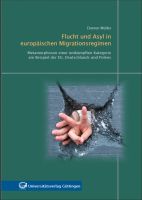Flucht und Asyl in europäischen Migrationsregimen - Metamorphosen einer umkämpften Kategorie am Beispiel der EU, Deutschlands und Polens
Author(s)
Müller, Doreen,
Collection
AG UniversitätsverlageLanguage
GermanAbstract
In the Federal Republic of Germany the number of asylum seekers has fallen considerably in recent years. The recognition rate lies at around one percent. What has happened to the refugees? Are there no longer any reasons to apply for asylum? In order to find asylum seekers, one must look in the new EU member states on the external borders, and to the countries immediately beyond the borders: because of regulations about jurisdiction, more and more refugees become stranded on the edges of the EU and can only reach other European target countries by irregular means. The study shows, using Germany and Poland as examples, how the significance of asylum law has changed over the last 20 years, how this change can be explained, and how it relates to migrants’ strategies. Inthis manner the study offers new insight into the field of asylum policy in three respects: on the one hand, asylum policy is analysed in the context of category construction related to migration policy. In this way the significance of the categorization and hierarchization of ‘desirable and ‘undesirable’ migrants as a central component of ‘migration management’ is revealed. On the other hand, the two studies of individual countries provide an extensive picture of asylum policy in Germany and Poland. By embedding the two case studies in developments at EU level, and relating them to each other, the study offers a new and comprehensive insight into the dynamics which have determined the changes in the European asylum regime in the last two decades. Die Zahl der Asylsuchenden ist in der Bundesrepublik Deutschland in den letzten Jahren stark zurückgegangen. Die Anerkennungsquote liegt bei rund einem Prozent. Wo sind die Flüchtlinge geblieben? Gibt es keine Gründe mehr, Asyl zu beantragen? Auf der Suche nach den AsylbewerberInnen wird man in den neueren EU-Mitgliedstaaten an den Außengrenzen und in den EU-Anrainerstaaten fündig: Aufgrund von Zuständigkeitsregelungen stranden immer mehr Flüchtlinge an den Rändern der EU und können andere europäische Zielländer nur noch irregulär erreichen. Die Studie zeigt am Beispiel Deutschlands und Polens, wie sich der Wandel des Asylrechts in den vergangenen 20 Jahren vollzogen hat, wie er erklärt werden kann und in welchem Verhältnis er zu den Strategien von MigrantInnen steht. Sie erschließt damit das Feld der Asylpolitik in dreierlei Hinsicht neu: Zum einen wird die Asylpolitik im Kontext migrationspolitischer Kategorienkonstruktionen analysiert. Auf diese Weise wird die Bedeutung der Kategorisierung und Hierarchisierung von ‚erwünschten‘ und ‚unerwünschten‘ MigrantInnen als zentraler Bestandteil des ‚Migrationsmanagements‘ aufgezeigt. Zum anderen liefern die beiden Länderstudien ein umfängliches Bild der Asylpolitik in Deutschland und Polen. Indem die beiden Fallstudien schließlich in die Entwicklungen auf EU-Ebene eingebettet und aufeinander bezogen werden, eröffnet die Studie einen neuen und umfassenden Einblick in die Dynamiken, die den Wandel des europäischen Asylregimes in den letzten zwei Jahrzehnten bestimmt haben.
Keywords
Demography; Geography; Asyl; Ausländerpolitik; Deutschland; Einwanderung; Europäische Union; PolenDOI
10.17875/gup2010-299Publisher
Universitätsverlag GöttingenPublication date and place
2010Classification
Society and Social Sciences
Refugees and political asylum
Political control and freedoms
Asylum law


 Download
Download Web Shop
Web Shop